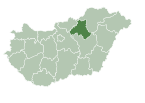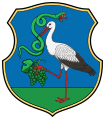Gyöngyössolymos
Gyöngyössolymos | |
|---|---|
Village | |
 Saint Nicholas Church | |
| Coordinates: 47°49′06″N 19°55′54″E / 47.81833°N 19.93167°E | |
| Country | |
| County | Heves |
| District | Gyöngyös |
| First mentioned | 1212 |
| Government | |
| • Mayor | Miklós Asztalos (Ind.) |
| Area | |
| • Total | 64.85 km2 (25.04 sq mi) |
| Population (2022) | |
| • Total | 2,820 |
| • Density | 43/km2 (110/sq mi) |
| Time zone | UTC+1 (CET) |
| • Summer (DST) | UTC+2 (CEST) |
| Postal code | 3231 |
| Area code | 37 |
| Website | www.gyongyossolymos.hu |

Gyöngyössolymos is a village in Heves County, Hungary, beside of the Gyöngyös creek, under the Mátra mountain ranges. As of 2022 census, it has a population of 2820 (see Demographics). The village located 4.6 km from (Nr. 85) Vámosgyörk–Gyöngyös railway line, 5.2 km from the main road 3 and 12.1 km from the M3 motorway. The closest train station with public transport in Gyöngyös on standard-gauge railway, but a narrow gauge railway line also going across the vilage.
History[edit]
Based on archaeological findings, the area was already inhabited in the Bronze Age. The first written mention of it dates from 1212, when King Andrew II donated an estate in the village to the Knights of the Holy Sepulchre. The settlement was owned by the Solymosy family, which built the settlement's church in the 14th century. The sources refer to the settlement as Solomus, Sumus, Solimus. A certificate from 1320 mentions the Dezsővár built by Dezső Solymosy north of the village, the ruins of which have not survived. The church was rebuilt in the Baroque style between 1769 and 1772, and its furnishings are in the Classicist style of the 19th century. The economic life of the village was determined by the mill industry from the 18th century, a watermill in the basement, which is now a museum, preserves the memory of this. Increased forestry activity justified the construction of the first narrow-gauge railway line to the Nagy valley in 1906, and the connecting line with Gyöngyös was built in 1918. Most of the lines were dismantled after 1968, and now only one line remains, which leads to the Szalajka House and operates for tourist purposes. A wildlife showing place, a spring and an educational trail have been established around the house. The Szalajka House was a former glass huta 8,7 km far from the village by railway and 4,1 km far from Mátraszentimre on marked hiking trail.[1]
Demographics[edit]
According the 2022 census, 91.5% of the population were of Hungarian ethnicity, 0.7% were Germans, and 8.1% were did not wish to answer. The religious distribution was as follows: 40.1% Roman Catholic, 3.4% Calvinist, 0.6% Greek Catholic, 10.1% non-denominational, and 42.4% did not wish to answer. 12 people live in an outskirt 1.0 km away of the village.[2]
Population by years:[3]
| Year | 1870 | 1880 | 1890 | 1900 | 1910 | 1920 | 1930 | 1941 |
|---|---|---|---|---|---|---|---|---|
| Population | 1678 | 1730 | 2040 | 2150 | 2362 | 2515 | 2747 | 3334 |
| Year | 1949 | 1960 | 1970 | 1980 | 1990 | 2001 | 2011 | 2022 |
| Population | 3234 | 3123 | 3051 | 3022 | 3203 | 3212 | 2988 | 2820 |
Politics[edit]
Mayors since 1990:
- 1990–2006: László Lukács (independent)[4][5][6][7][8]
- 2006–2014: Gyula Zsolt Szolcsák (independent)[9][10]
- 2014–2019: Zsuzsanna Nádudvari, Mrs. Nyilas (independent)[11]
- 2019–: Miklós Asztalos (independent)[12]
References[edit]
- ^ Habán, Ildikó (2015). Gyöngyössolymos. In.: Mátra tursitakaluz (in Hungarian). Budapest: Cartographia. p. 15,104. ISBN 978-963-353-143-3.
- ^ "Gyöngyössolymos". ksh.hu. Hungarian Central Statistical Office. Retrieved 9 July 2024.
- ^ "Population number, population density". Hungarian Central Statistical Office. Retrieved 2024-02-22.
- ^ "Gyöngyössolymos settlement election results" (txt) (in Hungarian). National Election Office. Retrieved 2024-07-09.
- ^ "Gyöngyössolymos settlement election results" (in Hungarian). National Election Office. Retrieved 2024-07-09.
- ^ "Gyöngyössolymos settlement election results" (in Hungarian). National Election Office. Retrieved 2024-07-09.
- ^ "A folytatásra voksoltak a szavazók (The voters voted to continue)" (pdf) (in Hungarian). Heves County's Newspaper. Retrieved 2024-07-09.
- ^ "Gyöngyössolymos settlement election results" (in Hungarian). National Election Office. Retrieved 2024-07-09.
- ^ "Gyöngyössolymos settlement election results" (in Hungarian). National Election Office. Retrieved 2024-07-09.
- ^ "Gyöngyössolymos settlement election results" (in Hungarian). National Election Office. Retrieved 2024-07-09.
- ^ "Gyöngyössolymos settlement election results" (in Hungarian). National Election Office. Retrieved 2024-07-09.
- ^ "Gyöngyössolymos settlement election results" (in Hungarian). National Election Office. Retrieved 2024-07-09.




